Case Study Assessment: Pathophysiology, Pharmacokinetics, Nursing Strategies, and Clinical Considerations
VerifiedAdded on 2023/06/12
|9
|2413
|375
AI Summary
This case study assessment focuses on pathophysiology problems, pharmacokinetics, nursing strategies, effective patient's education, and clinical considerations for a 76-year-old male patient with chest heaviness. It includes pain management, blood pressure management, angina control, fluid volume management, and temperature control.
Contribute Materials
Your contribution can guide someone’s learning journey. Share your
documents today.
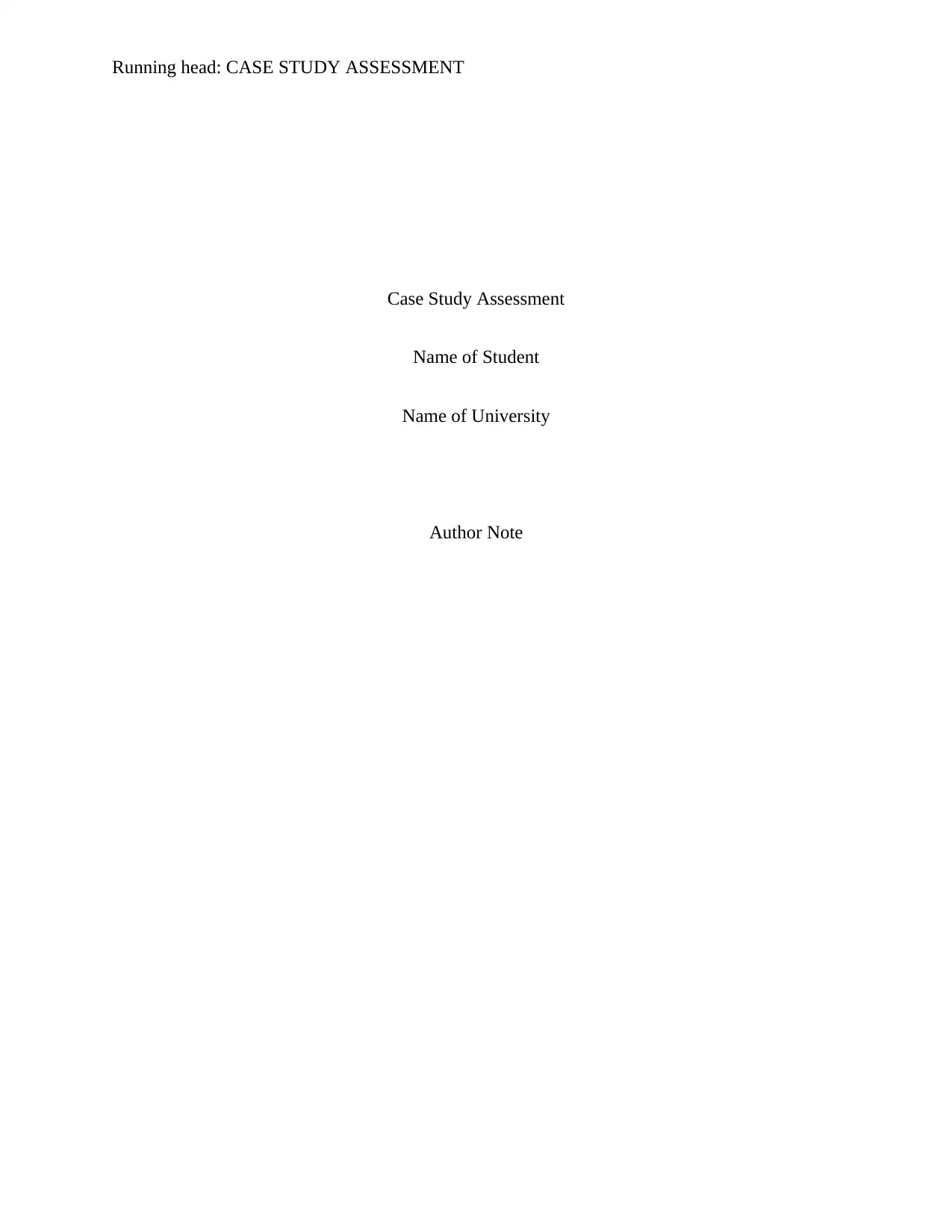
Running head: CASE STUDY ASSESSMENT
Case Study Assessment
Name of Student
Name of University
Author Note
Case Study Assessment
Name of Student
Name of University
Author Note
Secure Best Marks with AI Grader
Need help grading? Try our AI Grader for instant feedback on your assignments.
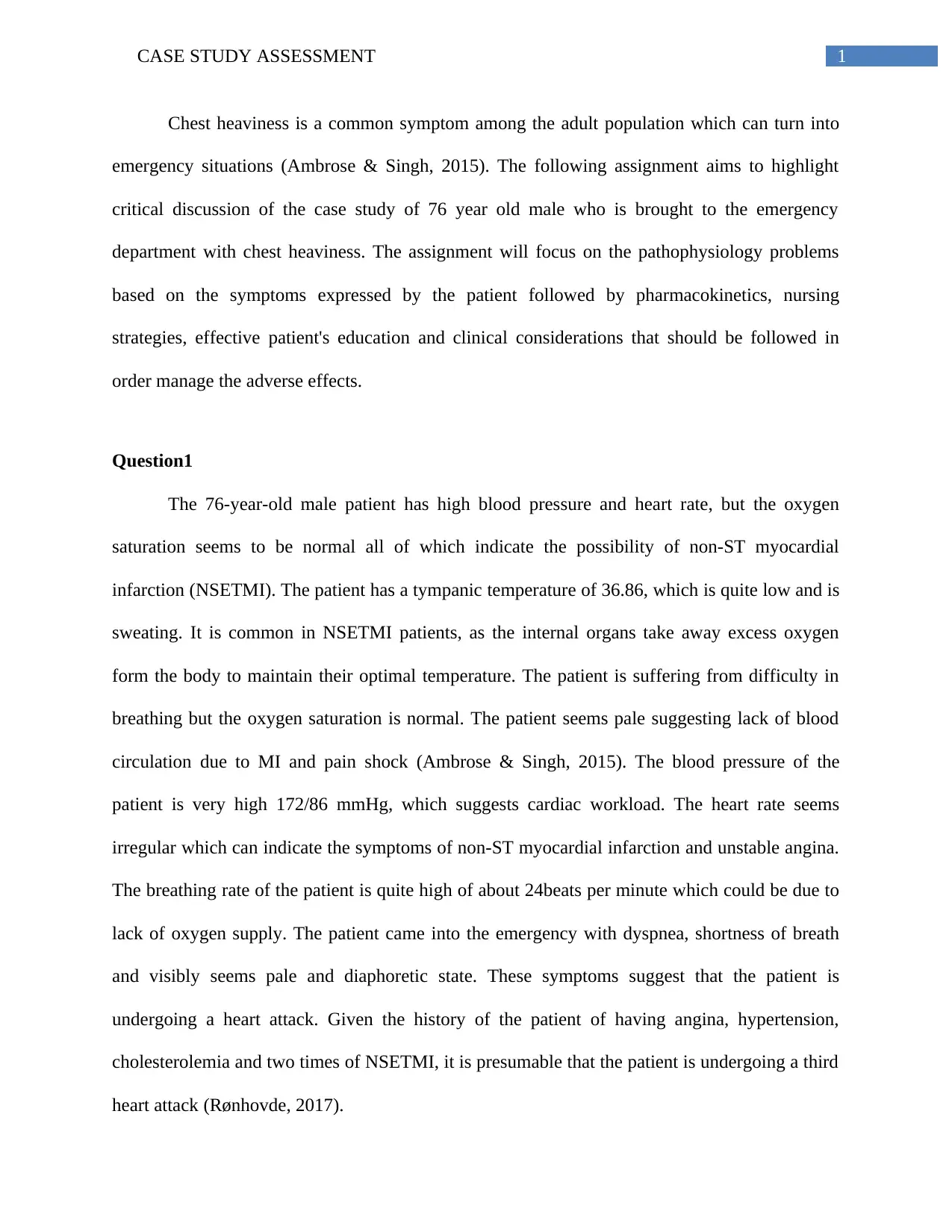
1CASE STUDY ASSESSMENT
Chest heaviness is a common symptom among the adult population which can turn into
emergency situations (Ambrose & Singh, 2015). The following assignment aims to highlight
critical discussion of the case study of 76 year old male who is brought to the emergency
department with chest heaviness. The assignment will focus on the pathophysiology problems
based on the symptoms expressed by the patient followed by pharmacokinetics, nursing
strategies, effective patient's education and clinical considerations that should be followed in
order manage the adverse effects.
Question1
The 76-year-old male patient has high blood pressure and heart rate, but the oxygen
saturation seems to be normal all of which indicate the possibility of non-ST myocardial
infarction (NSETMI). The patient has a tympanic temperature of 36.86, which is quite low and is
sweating. It is common in NSETMI patients, as the internal organs take away excess oxygen
form the body to maintain their optimal temperature. The patient is suffering from difficulty in
breathing but the oxygen saturation is normal. The patient seems pale suggesting lack of blood
circulation due to MI and pain shock (Ambrose & Singh, 2015). The blood pressure of the
patient is very high 172/86 mmHg, which suggests cardiac workload. The heart rate seems
irregular which can indicate the symptoms of non-ST myocardial infarction and unstable angina.
The breathing rate of the patient is quite high of about 24beats per minute which could be due to
lack of oxygen supply. The patient came into the emergency with dyspnea, shortness of breath
and visibly seems pale and diaphoretic state. These symptoms suggest that the patient is
undergoing a heart attack. Given the history of the patient of having angina, hypertension,
cholesterolemia and two times of NSETMI, it is presumable that the patient is undergoing a third
heart attack (Rønhovde, 2017).
Chest heaviness is a common symptom among the adult population which can turn into
emergency situations (Ambrose & Singh, 2015). The following assignment aims to highlight
critical discussion of the case study of 76 year old male who is brought to the emergency
department with chest heaviness. The assignment will focus on the pathophysiology problems
based on the symptoms expressed by the patient followed by pharmacokinetics, nursing
strategies, effective patient's education and clinical considerations that should be followed in
order manage the adverse effects.
Question1
The 76-year-old male patient has high blood pressure and heart rate, but the oxygen
saturation seems to be normal all of which indicate the possibility of non-ST myocardial
infarction (NSETMI). The patient has a tympanic temperature of 36.86, which is quite low and is
sweating. It is common in NSETMI patients, as the internal organs take away excess oxygen
form the body to maintain their optimal temperature. The patient is suffering from difficulty in
breathing but the oxygen saturation is normal. The patient seems pale suggesting lack of blood
circulation due to MI and pain shock (Ambrose & Singh, 2015). The blood pressure of the
patient is very high 172/86 mmHg, which suggests cardiac workload. The heart rate seems
irregular which can indicate the symptoms of non-ST myocardial infarction and unstable angina.
The breathing rate of the patient is quite high of about 24beats per minute which could be due to
lack of oxygen supply. The patient came into the emergency with dyspnea, shortness of breath
and visibly seems pale and diaphoretic state. These symptoms suggest that the patient is
undergoing a heart attack. Given the history of the patient of having angina, hypertension,
cholesterolemia and two times of NSETMI, it is presumable that the patient is undergoing a third
heart attack (Rønhovde, 2017).

2CASE STUDY ASSESSMENT
Question 2
The patient was prescribed dose of 300 mg of aspirin, 2.5 mg of Morphine administered
on four different occasions as required for the situation intravenously. The patient was infused
with low molecular weight heparin and 50mcg Fentanyl twice with immediate effect. The
pharmacokinetics of these drugs are described in the following-
Aspirin 300mg: The analgesic aspirin is used to treat moderate to severe depending on
the situation but it is also sometimes used as an anticoagulant for prevention of myocardial
infection and other heart related abnormalities (Saxena et al., 2013). Inactive form of aspirin is
readily observed in the acidic environment of the stomach where it is broken down into acetyl
group and salicylate which further is observed why the small intestine. Acetylsalicylic inhibits
platelet aggregation which is why it is used as an anticoagulant. The acetyl group of the drug
binds to cyclo-oxygenase (COX 1 and 2) enzymes, which inhibit prostaglandin and thromboxane
production from arachidonic acid. The acetylsalicylate portion facilitates antipyresis, thermal
induction and vasodilatation (Thorat & Cuzick, 2013).
Morphine sulphate IV 2.5mg: Morphine is another drug which is used to reduce severe
pain related to angina surgery or trauma. The gastrointestinal mucosal lining readily absorbs
morphine and rapidly circulated throughout the body. morphine hypothesized to bind and inhibit
to GABA inhibitory mediator neurons, which reduce the transmission of pain signals (Kubica et
al., 2015).
Low Molecular weight Heparin (LMWH) infusion: Low molecular weight heparin is a
very common form of anticoagulant drug that prevents blood coagulation clots as well as
thrombo-embolism in deep vein as well as in pulmonary conditions. It is mainly used to treat
Question 2
The patient was prescribed dose of 300 mg of aspirin, 2.5 mg of Morphine administered
on four different occasions as required for the situation intravenously. The patient was infused
with low molecular weight heparin and 50mcg Fentanyl twice with immediate effect. The
pharmacokinetics of these drugs are described in the following-
Aspirin 300mg: The analgesic aspirin is used to treat moderate to severe depending on
the situation but it is also sometimes used as an anticoagulant for prevention of myocardial
infection and other heart related abnormalities (Saxena et al., 2013). Inactive form of aspirin is
readily observed in the acidic environment of the stomach where it is broken down into acetyl
group and salicylate which further is observed why the small intestine. Acetylsalicylic inhibits
platelet aggregation which is why it is used as an anticoagulant. The acetyl group of the drug
binds to cyclo-oxygenase (COX 1 and 2) enzymes, which inhibit prostaglandin and thromboxane
production from arachidonic acid. The acetylsalicylate portion facilitates antipyresis, thermal
induction and vasodilatation (Thorat & Cuzick, 2013).
Morphine sulphate IV 2.5mg: Morphine is another drug which is used to reduce severe
pain related to angina surgery or trauma. The gastrointestinal mucosal lining readily absorbs
morphine and rapidly circulated throughout the body. morphine hypothesized to bind and inhibit
to GABA inhibitory mediator neurons, which reduce the transmission of pain signals (Kubica et
al., 2015).
Low Molecular weight Heparin (LMWH) infusion: Low molecular weight heparin is a
very common form of anticoagulant drug that prevents blood coagulation clots as well as
thrombo-embolism in deep vein as well as in pulmonary conditions. It is mainly used to treat
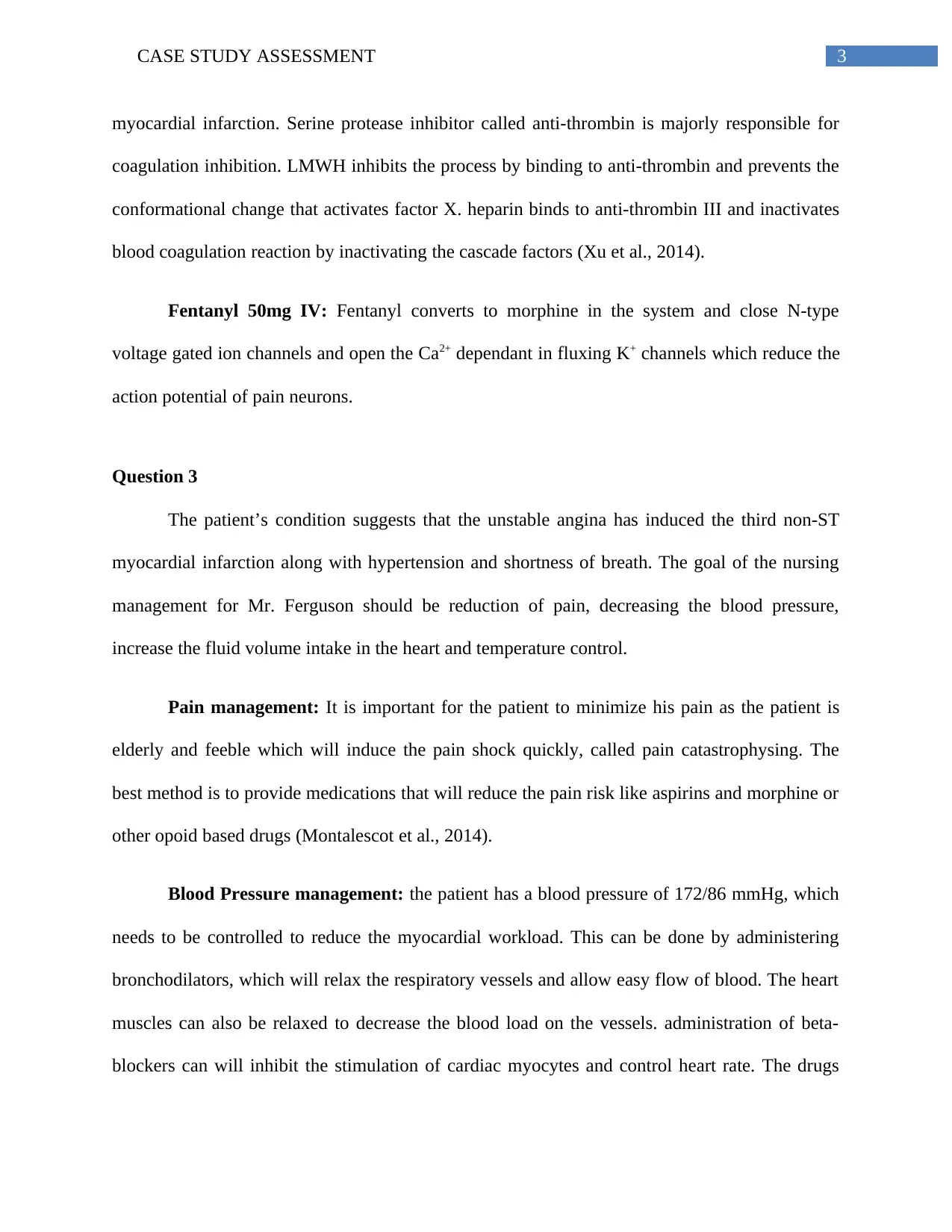
3CASE STUDY ASSESSMENT
myocardial infarction. Serine protease inhibitor called anti-thrombin is majorly responsible for
coagulation inhibition. LMWH inhibits the process by binding to anti-thrombin and prevents the
conformational change that activates factor X. heparin binds to anti-thrombin III and inactivates
blood coagulation reaction by inactivating the cascade factors (Xu et al., 2014).
Fentanyl 50mg IV: Fentanyl converts to morphine in the system and close N-type
voltage gated ion channels and open the Ca2+ dependant in fluxing K+ channels which reduce the
action potential of pain neurons.
Question 3
The patient’s condition suggests that the unstable angina has induced the third non-ST
myocardial infarction along with hypertension and shortness of breath. The goal of the nursing
management for Mr. Ferguson should be reduction of pain, decreasing the blood pressure,
increase the fluid volume intake in the heart and temperature control.
Pain management: It is important for the patient to minimize his pain as the patient is
elderly and feeble which will induce the pain shock quickly, called pain catastrophysing. The
best method is to provide medications that will reduce the pain risk like aspirins and morphine or
other opoid based drugs (Montalescot et al., 2014).
Blood Pressure management: the patient has a blood pressure of 172/86 mmHg, which
needs to be controlled to reduce the myocardial workload. This can be done by administering
bronchodilators, which will relax the respiratory vessels and allow easy flow of blood. The heart
muscles can also be relaxed to decrease the blood load on the vessels. administration of beta-
blockers can will inhibit the stimulation of cardiac myocytes and control heart rate. The drugs
myocardial infarction. Serine protease inhibitor called anti-thrombin is majorly responsible for
coagulation inhibition. LMWH inhibits the process by binding to anti-thrombin and prevents the
conformational change that activates factor X. heparin binds to anti-thrombin III and inactivates
blood coagulation reaction by inactivating the cascade factors (Xu et al., 2014).
Fentanyl 50mg IV: Fentanyl converts to morphine in the system and close N-type
voltage gated ion channels and open the Ca2+ dependant in fluxing K+ channels which reduce the
action potential of pain neurons.
Question 3
The patient’s condition suggests that the unstable angina has induced the third non-ST
myocardial infarction along with hypertension and shortness of breath. The goal of the nursing
management for Mr. Ferguson should be reduction of pain, decreasing the blood pressure,
increase the fluid volume intake in the heart and temperature control.
Pain management: It is important for the patient to minimize his pain as the patient is
elderly and feeble which will induce the pain shock quickly, called pain catastrophysing. The
best method is to provide medications that will reduce the pain risk like aspirins and morphine or
other opoid based drugs (Montalescot et al., 2014).
Blood Pressure management: the patient has a blood pressure of 172/86 mmHg, which
needs to be controlled to reduce the myocardial workload. This can be done by administering
bronchodilators, which will relax the respiratory vessels and allow easy flow of blood. The heart
muscles can also be relaxed to decrease the blood load on the vessels. administration of beta-
blockers can will inhibit the stimulation of cardiac myocytes and control heart rate. The drugs
Secure Best Marks with AI Grader
Need help grading? Try our AI Grader for instant feedback on your assignments.
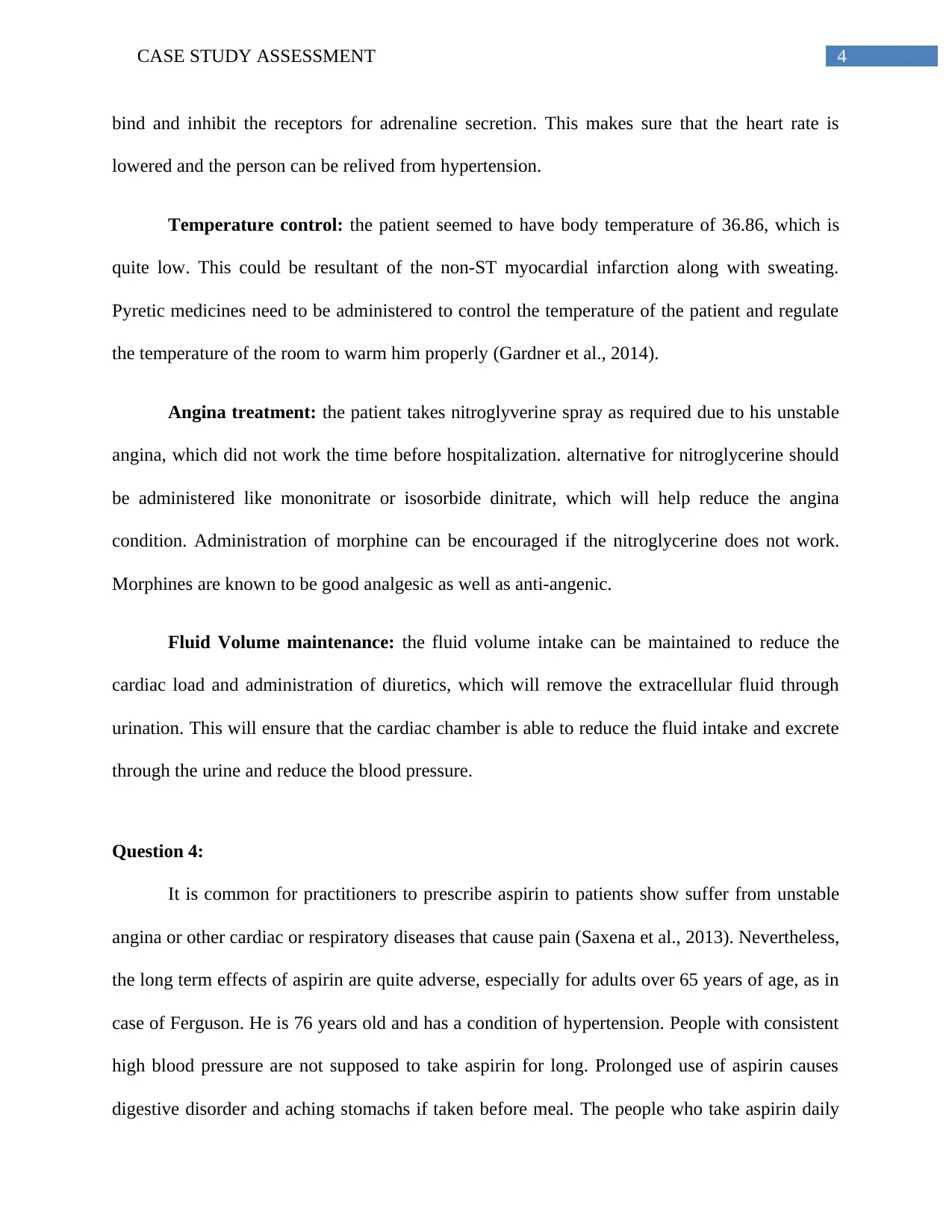
4CASE STUDY ASSESSMENT
bind and inhibit the receptors for adrenaline secretion. This makes sure that the heart rate is
lowered and the person can be relived from hypertension.
Temperature control: the patient seemed to have body temperature of 36.86, which is
quite low. This could be resultant of the non-ST myocardial infarction along with sweating.
Pyretic medicines need to be administered to control the temperature of the patient and regulate
the temperature of the room to warm him properly (Gardner et al., 2014).
Angina treatment: the patient takes nitroglyverine spray as required due to his unstable
angina, which did not work the time before hospitalization. alternative for nitroglycerine should
be administered like mononitrate or isosorbide dinitrate, which will help reduce the angina
condition. Administration of morphine can be encouraged if the nitroglycerine does not work.
Morphines are known to be good analgesic as well as anti-angenic.
Fluid Volume maintenance: the fluid volume intake can be maintained to reduce the
cardiac load and administration of diuretics, which will remove the extracellular fluid through
urination. This will ensure that the cardiac chamber is able to reduce the fluid intake and excrete
through the urine and reduce the blood pressure.
Question 4:
It is common for practitioners to prescribe aspirin to patients show suffer from unstable
angina or other cardiac or respiratory diseases that cause pain (Saxena et al., 2013). Nevertheless,
the long term effects of aspirin are quite adverse, especially for adults over 65 years of age, as in
case of Ferguson. He is 76 years old and has a condition of hypertension. People with consistent
high blood pressure are not supposed to take aspirin for long. Prolonged use of aspirin causes
digestive disorder and aching stomachs if taken before meal. The people who take aspirin daily
bind and inhibit the receptors for adrenaline secretion. This makes sure that the heart rate is
lowered and the person can be relived from hypertension.
Temperature control: the patient seemed to have body temperature of 36.86, which is
quite low. This could be resultant of the non-ST myocardial infarction along with sweating.
Pyretic medicines need to be administered to control the temperature of the patient and regulate
the temperature of the room to warm him properly (Gardner et al., 2014).
Angina treatment: the patient takes nitroglyverine spray as required due to his unstable
angina, which did not work the time before hospitalization. alternative for nitroglycerine should
be administered like mononitrate or isosorbide dinitrate, which will help reduce the angina
condition. Administration of morphine can be encouraged if the nitroglycerine does not work.
Morphines are known to be good analgesic as well as anti-angenic.
Fluid Volume maintenance: the fluid volume intake can be maintained to reduce the
cardiac load and administration of diuretics, which will remove the extracellular fluid through
urination. This will ensure that the cardiac chamber is able to reduce the fluid intake and excrete
through the urine and reduce the blood pressure.
Question 4:
It is common for practitioners to prescribe aspirin to patients show suffer from unstable
angina or other cardiac or respiratory diseases that cause pain (Saxena et al., 2013). Nevertheless,
the long term effects of aspirin are quite adverse, especially for adults over 65 years of age, as in
case of Ferguson. He is 76 years old and has a condition of hypertension. People with consistent
high blood pressure are not supposed to take aspirin for long. Prolonged use of aspirin causes
digestive disorder and aching stomachs if taken before meal. The people who take aspirin daily
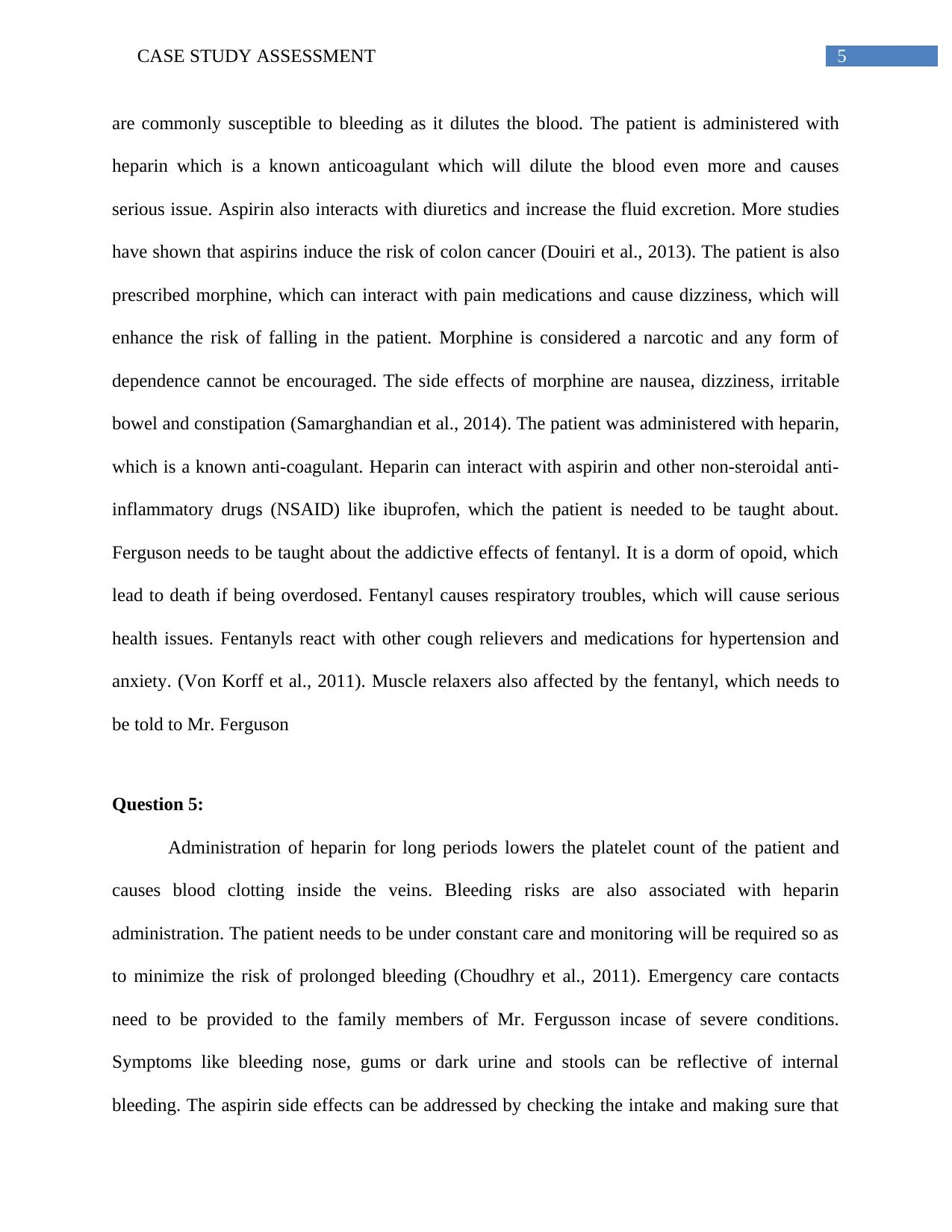
5CASE STUDY ASSESSMENT
are commonly susceptible to bleeding as it dilutes the blood. The patient is administered with
heparin which is a known anticoagulant which will dilute the blood even more and causes
serious issue. Aspirin also interacts with diuretics and increase the fluid excretion. More studies
have shown that aspirins induce the risk of colon cancer (Douiri et al., 2013). The patient is also
prescribed morphine, which can interact with pain medications and cause dizziness, which will
enhance the risk of falling in the patient. Morphine is considered a narcotic and any form of
dependence cannot be encouraged. The side effects of morphine are nausea, dizziness, irritable
bowel and constipation (Samarghandian et al., 2014). The patient was administered with heparin,
which is a known anti-coagulant. Heparin can interact with aspirin and other non-steroidal anti-
inflammatory drugs (NSAID) like ibuprofen, which the patient is needed to be taught about.
Ferguson needs to be taught about the addictive effects of fentanyl. It is a dorm of opoid, which
lead to death if being overdosed. Fentanyl causes respiratory troubles, which will cause serious
health issues. Fentanyls react with other cough relievers and medications for hypertension and
anxiety. (Von Korff et al., 2011). Muscle relaxers also affected by the fentanyl, which needs to
be told to Mr. Ferguson
Question 5:
Administration of heparin for long periods lowers the platelet count of the patient and
causes blood clotting inside the veins. Bleeding risks are also associated with heparin
administration. The patient needs to be under constant care and monitoring will be required so as
to minimize the risk of prolonged bleeding (Choudhry et al., 2011). Emergency care contacts
need to be provided to the family members of Mr. Fergusson incase of severe conditions.
Symptoms like bleeding nose, gums or dark urine and stools can be reflective of internal
bleeding. The aspirin side effects can be addressed by checking the intake and making sure that
are commonly susceptible to bleeding as it dilutes the blood. The patient is administered with
heparin which is a known anticoagulant which will dilute the blood even more and causes
serious issue. Aspirin also interacts with diuretics and increase the fluid excretion. More studies
have shown that aspirins induce the risk of colon cancer (Douiri et al., 2013). The patient is also
prescribed morphine, which can interact with pain medications and cause dizziness, which will
enhance the risk of falling in the patient. Morphine is considered a narcotic and any form of
dependence cannot be encouraged. The side effects of morphine are nausea, dizziness, irritable
bowel and constipation (Samarghandian et al., 2014). The patient was administered with heparin,
which is a known anti-coagulant. Heparin can interact with aspirin and other non-steroidal anti-
inflammatory drugs (NSAID) like ibuprofen, which the patient is needed to be taught about.
Ferguson needs to be taught about the addictive effects of fentanyl. It is a dorm of opoid, which
lead to death if being overdosed. Fentanyl causes respiratory troubles, which will cause serious
health issues. Fentanyls react with other cough relievers and medications for hypertension and
anxiety. (Von Korff et al., 2011). Muscle relaxers also affected by the fentanyl, which needs to
be told to Mr. Ferguson
Question 5:
Administration of heparin for long periods lowers the platelet count of the patient and
causes blood clotting inside the veins. Bleeding risks are also associated with heparin
administration. The patient needs to be under constant care and monitoring will be required so as
to minimize the risk of prolonged bleeding (Choudhry et al., 2011). Emergency care contacts
need to be provided to the family members of Mr. Fergusson incase of severe conditions.
Symptoms like bleeding nose, gums or dark urine and stools can be reflective of internal
bleeding. The aspirin side effects can be addressed by checking the intake and making sure that
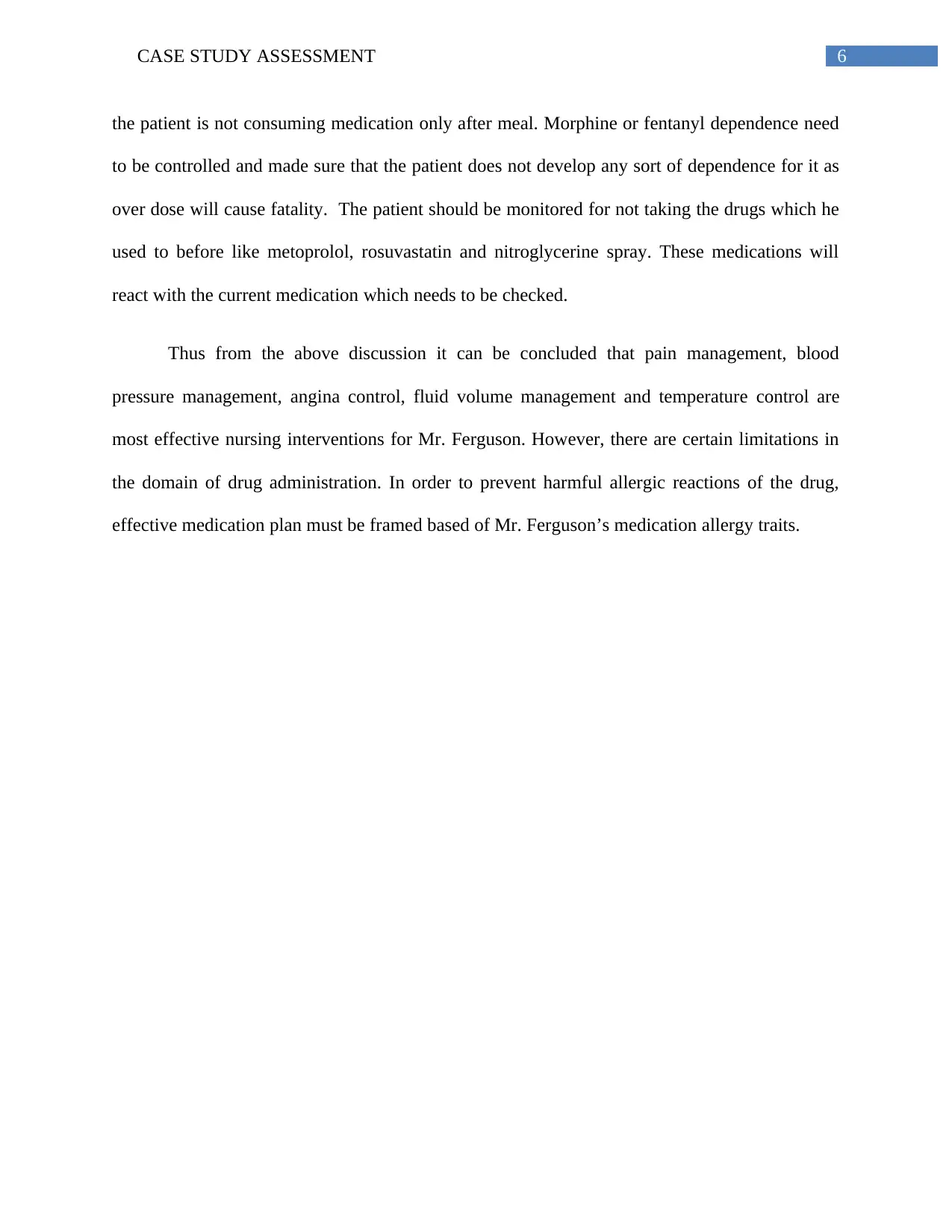
6CASE STUDY ASSESSMENT
the patient is not consuming medication only after meal. Morphine or fentanyl dependence need
to be controlled and made sure that the patient does not develop any sort of dependence for it as
over dose will cause fatality. The patient should be monitored for not taking the drugs which he
used to before like metoprolol, rosuvastatin and nitroglycerine spray. These medications will
react with the current medication which needs to be checked.
Thus from the above discussion it can be concluded that pain management, blood
pressure management, angina control, fluid volume management and temperature control are
most effective nursing interventions for Mr. Ferguson. However, there are certain limitations in
the domain of drug administration. In order to prevent harmful allergic reactions of the drug,
effective medication plan must be framed based of Mr. Ferguson’s medication allergy traits.
the patient is not consuming medication only after meal. Morphine or fentanyl dependence need
to be controlled and made sure that the patient does not develop any sort of dependence for it as
over dose will cause fatality. The patient should be monitored for not taking the drugs which he
used to before like metoprolol, rosuvastatin and nitroglycerine spray. These medications will
react with the current medication which needs to be checked.
Thus from the above discussion it can be concluded that pain management, blood
pressure management, angina control, fluid volume management and temperature control are
most effective nursing interventions for Mr. Ferguson. However, there are certain limitations in
the domain of drug administration. In order to prevent harmful allergic reactions of the drug,
effective medication plan must be framed based of Mr. Ferguson’s medication allergy traits.
Paraphrase This Document
Need a fresh take? Get an instant paraphrase of this document with our AI Paraphraser
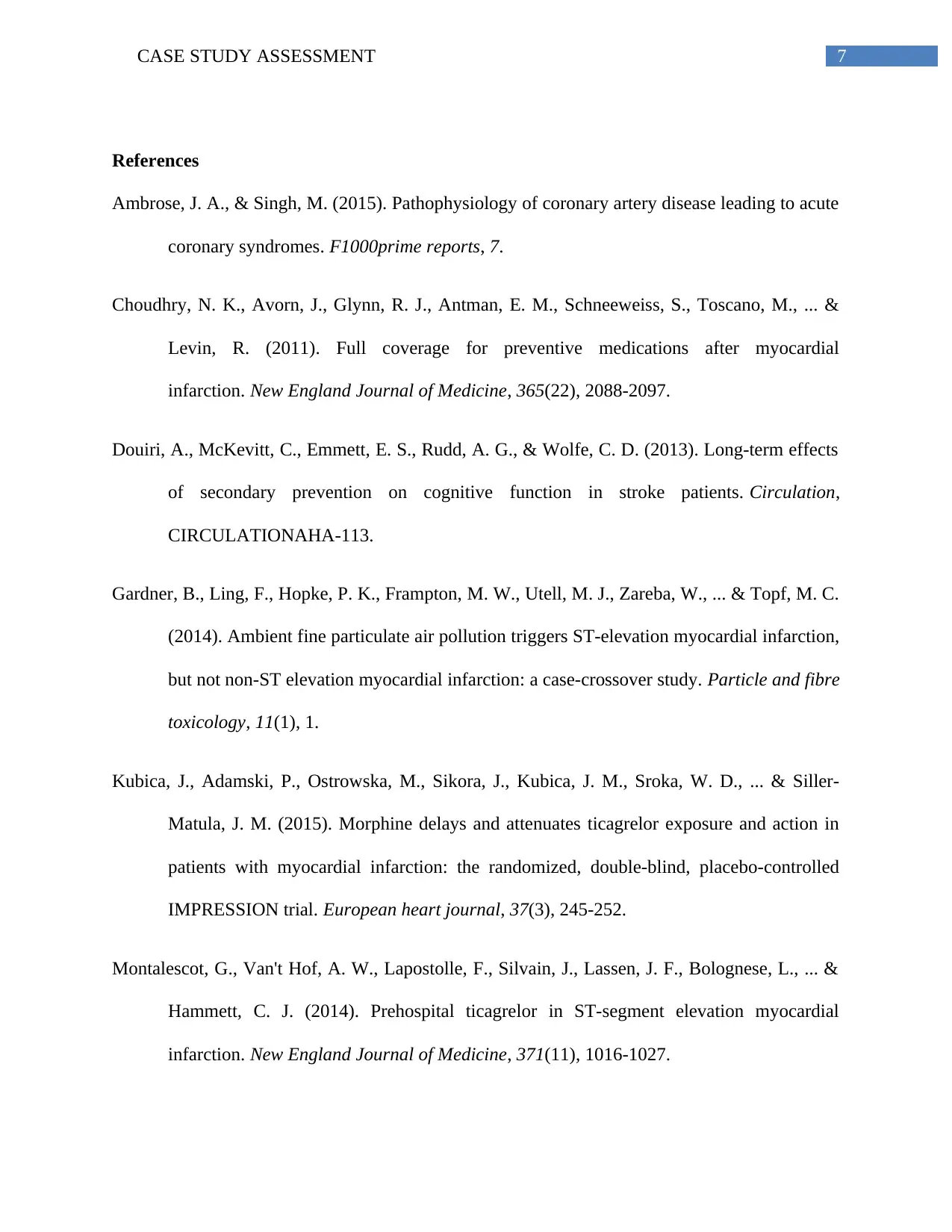
7CASE STUDY ASSESSMENT
References
Ambrose, J. A., & Singh, M. (2015). Pathophysiology of coronary artery disease leading to acute
coronary syndromes. F1000prime reports, 7.
Choudhry, N. K., Avorn, J., Glynn, R. J., Antman, E. M., Schneeweiss, S., Toscano, M., ... &
Levin, R. (2011). Full coverage for preventive medications after myocardial
infarction. New England Journal of Medicine, 365(22), 2088-2097.
Douiri, A., McKevitt, C., Emmett, E. S., Rudd, A. G., & Wolfe, C. D. (2013). Long-term effects
of secondary prevention on cognitive function in stroke patients. Circulation,
CIRCULATIONAHA-113.
Gardner, B., Ling, F., Hopke, P. K., Frampton, M. W., Utell, M. J., Zareba, W., ... & Topf, M. C.
(2014). Ambient fine particulate air pollution triggers ST-elevation myocardial infarction,
but not non-ST elevation myocardial infarction: a case-crossover study. Particle and fibre
toxicology, 11(1), 1.
Kubica, J., Adamski, P., Ostrowska, M., Sikora, J., Kubica, J. M., Sroka, W. D., ... & Siller-
Matula, J. M. (2015). Morphine delays and attenuates ticagrelor exposure and action in
patients with myocardial infarction: the randomized, double-blind, placebo-controlled
IMPRESSION trial. European heart journal, 37(3), 245-252.
Montalescot, G., Van't Hof, A. W., Lapostolle, F., Silvain, J., Lassen, J. F., Bolognese, L., ... &
Hammett, C. J. (2014). Prehospital ticagrelor in ST-segment elevation myocardial
infarction. New England Journal of Medicine, 371(11), 1016-1027.
References
Ambrose, J. A., & Singh, M. (2015). Pathophysiology of coronary artery disease leading to acute
coronary syndromes. F1000prime reports, 7.
Choudhry, N. K., Avorn, J., Glynn, R. J., Antman, E. M., Schneeweiss, S., Toscano, M., ... &
Levin, R. (2011). Full coverage for preventive medications after myocardial
infarction. New England Journal of Medicine, 365(22), 2088-2097.
Douiri, A., McKevitt, C., Emmett, E. S., Rudd, A. G., & Wolfe, C. D. (2013). Long-term effects
of secondary prevention on cognitive function in stroke patients. Circulation,
CIRCULATIONAHA-113.
Gardner, B., Ling, F., Hopke, P. K., Frampton, M. W., Utell, M. J., Zareba, W., ... & Topf, M. C.
(2014). Ambient fine particulate air pollution triggers ST-elevation myocardial infarction,
but not non-ST elevation myocardial infarction: a case-crossover study. Particle and fibre
toxicology, 11(1), 1.
Kubica, J., Adamski, P., Ostrowska, M., Sikora, J., Kubica, J. M., Sroka, W. D., ... & Siller-
Matula, J. M. (2015). Morphine delays and attenuates ticagrelor exposure and action in
patients with myocardial infarction: the randomized, double-blind, placebo-controlled
IMPRESSION trial. European heart journal, 37(3), 245-252.
Montalescot, G., Van't Hof, A. W., Lapostolle, F., Silvain, J., Lassen, J. F., Bolognese, L., ... &
Hammett, C. J. (2014). Prehospital ticagrelor in ST-segment elevation myocardial
infarction. New England Journal of Medicine, 371(11), 1016-1027.
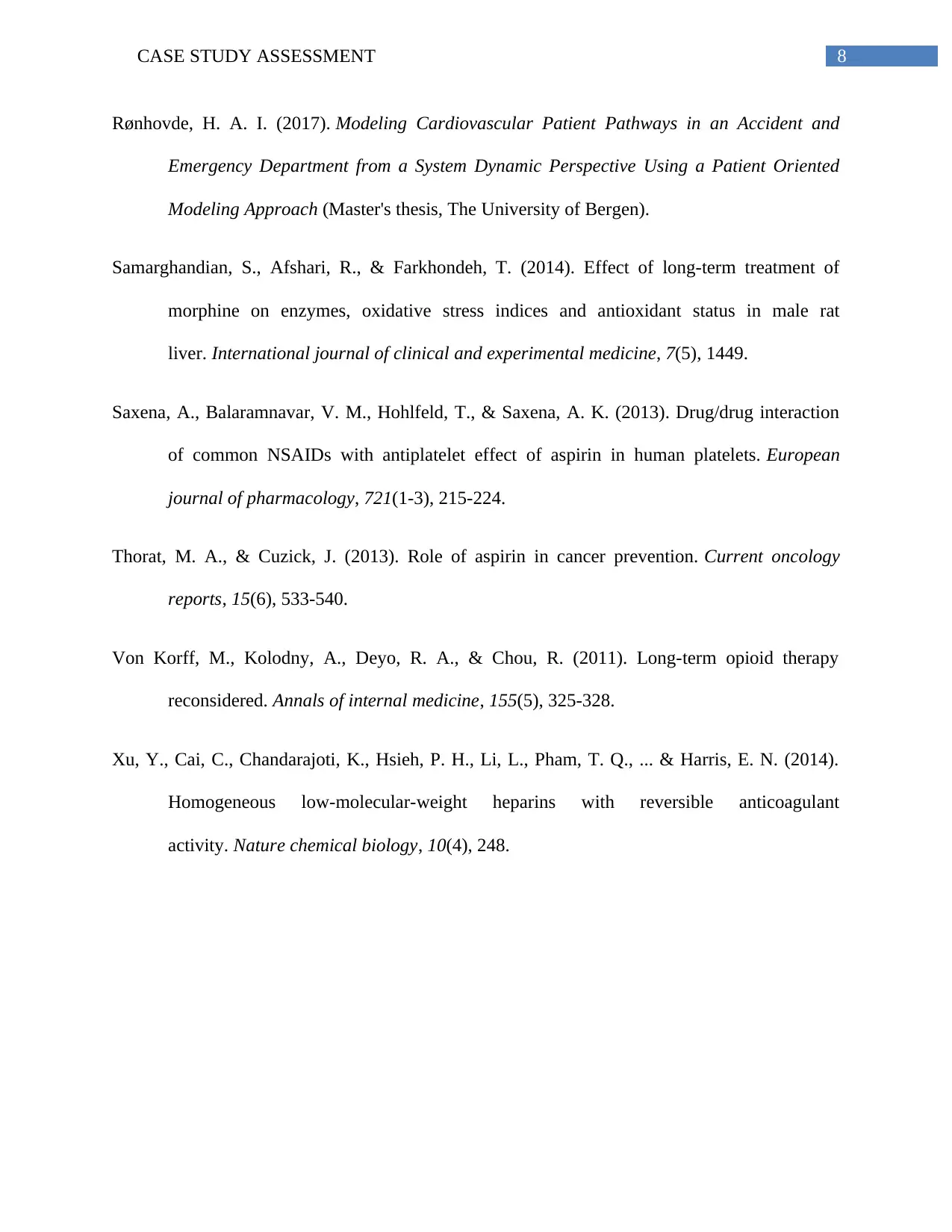
8CASE STUDY ASSESSMENT
Rønhovde, H. A. I. (2017). Modeling Cardiovascular Patient Pathways in an Accident and
Emergency Department from a System Dynamic Perspective Using a Patient Oriented
Modeling Approach (Master's thesis, The University of Bergen).
Samarghandian, S., Afshari, R., & Farkhondeh, T. (2014). Effect of long-term treatment of
morphine on enzymes, oxidative stress indices and antioxidant status in male rat
liver. International journal of clinical and experimental medicine, 7(5), 1449.
Saxena, A., Balaramnavar, V. M., Hohlfeld, T., & Saxena, A. K. (2013). Drug/drug interaction
of common NSAIDs with antiplatelet effect of aspirin in human platelets. European
journal of pharmacology, 721(1-3), 215-224.
Thorat, M. A., & Cuzick, J. (2013). Role of aspirin in cancer prevention. Current oncology
reports, 15(6), 533-540.
Von Korff, M., Kolodny, A., Deyo, R. A., & Chou, R. (2011). Long-term opioid therapy
reconsidered. Annals of internal medicine, 155(5), 325-328.
Xu, Y., Cai, C., Chandarajoti, K., Hsieh, P. H., Li, L., Pham, T. Q., ... & Harris, E. N. (2014).
Homogeneous low-molecular-weight heparins with reversible anticoagulant
activity. Nature chemical biology, 10(4), 248.
Rønhovde, H. A. I. (2017). Modeling Cardiovascular Patient Pathways in an Accident and
Emergency Department from a System Dynamic Perspective Using a Patient Oriented
Modeling Approach (Master's thesis, The University of Bergen).
Samarghandian, S., Afshari, R., & Farkhondeh, T. (2014). Effect of long-term treatment of
morphine on enzymes, oxidative stress indices and antioxidant status in male rat
liver. International journal of clinical and experimental medicine, 7(5), 1449.
Saxena, A., Balaramnavar, V. M., Hohlfeld, T., & Saxena, A. K. (2013). Drug/drug interaction
of common NSAIDs with antiplatelet effect of aspirin in human platelets. European
journal of pharmacology, 721(1-3), 215-224.
Thorat, M. A., & Cuzick, J. (2013). Role of aspirin in cancer prevention. Current oncology
reports, 15(6), 533-540.
Von Korff, M., Kolodny, A., Deyo, R. A., & Chou, R. (2011). Long-term opioid therapy
reconsidered. Annals of internal medicine, 155(5), 325-328.
Xu, Y., Cai, C., Chandarajoti, K., Hsieh, P. H., Li, L., Pham, T. Q., ... & Harris, E. N. (2014).
Homogeneous low-molecular-weight heparins with reversible anticoagulant
activity. Nature chemical biology, 10(4), 248.
1 out of 9
Related Documents
Your All-in-One AI-Powered Toolkit for Academic Success.
+13062052269
info@desklib.com
Available 24*7 on WhatsApp / Email
![[object Object]](/_next/static/media/star-bottom.7253800d.svg)
Unlock your academic potential
© 2024 | Zucol Services PVT LTD | All rights reserved.





